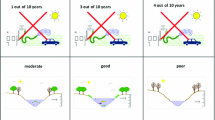Abstract
Referendum style willingness to pay questions have been used to estimatepassive use values. This referendum question format method may beproblematic for many reasons, including the statistical techniques used toestimate willingness to pay from discrete responses. This paper comparesa number of parametric, semi-nonparametric and nonparametric estimationtechniques using data collected from US households regarding Federalprotection of endangered fish species.The advantages and disadvantagesof the various statistical models used are explored. A hypothesis test forstatistical equality among estimation techniques is performed using ajackknife bootstrapping method. When the equality test is applied, themodeling techniques do show significant differences in some possiblecomparisons, but only those that are nonparamentric. This can lead toconflicting interpretations of what the data show. Resource managers andpolicy analysts need to use caution when interpreting results until anindustry standard can be developed for estimating willingness to pay fromclosed ended questions.
Similar content being viewed by others
REFERENCES
Bishop, R. and T. Heberlein (1979), ‘Measuring Values of Extra Market Goods: Are Indirect Measures Biased?’, American Journal of Agricultural Economics 61, 926–930.
Chen, H. Z. and A. Randall (1997), ‘Semi-Parametric Estimation of Binary Response Models with an Application to Natural Resource Valuation’, Journal of Econometrics 76(1–2), 323–340.
Cleymaet, R. (1998), Use of CVM in Cost-Benefit Analysis of Nine Threatened and Endangered Fish Species in the Colorado River Basin. Technical Paper, Colorado State University, Department of Agricultural and Resource Economics.
Cooper, J. (2000), ‘Nonparametric and Semi-Parametric Travel Cost Methods’, American Journal of Agricultural Economics (May) 82, 245–259.
Cooper, J. and D. Hellerstein (1989), CVM: A Set of CVM Estimators. Washington, DC: USDS/ERS. http://rpbcam.econ.ag.gov/GOGRBL
Creel, M. and J. Loomis (1997), ‘Semi-Nonparamentric, Distribution Free Dichotomous Choice Contingent Valuation’, Journal of Environmental Economics and Management 32(3), 341–358.
Creel, M. (1995), ‘A Semi-nonparametric, Distribution Free Estimator for Binary Discrete Responses’, Revision of Working Paper 267.94. Department of Economics and Economic History, University Autonoma de Barcelona.
Cummings, R., G. Harrison and E. E. Rutstrom (1995), ‘Homegrown Values and Hypothetical Surveys: Is Dichotomous Choice Approach Incentive Compatible?’, American Economic Review 85, 260–266.
Diamond, P. and J. Hausman (1994), ‘Contingent Valuation: Is Some Number Better Than No Number?’, Journal of Economic Perspectives 8(4), 45–64.
Dilman, D. (1978), Mail and Telephone Surveys. New York: John Wiley and Sons.
Duffield, J. and D. Patterson (1991), ‘Inference and Optimal Design for a Welfare Measure in Dichotomous Choice Contingent Valuation’, Land Economics 67(2), 225–239.
Efron, B. (1987), ‘Better Bootstrap Confidence Intervals’, Journal of the American Statistical Association 82(397), 171–185.
Gallant, A. (1982), ‘Unbiased Determination of Production Technologies’, Journal of Econometrics 20, 285–323.
Flores, N. (1996), ‘Reconsidering the Use of Hicks Neutrality to Recover Total Values’, Journal of Environmental Economics and Management 31(1), 49–64.
GAUSS forWindows NT/95 Version 3.2.32 (Dec 19 1997). Aptech Systems, Inc. Maple Valley,WA.
Haab, T. and K. McConnell (1997), ‘Referendum Models and Negative Willingness to Pay: Alternative Solutions’, Land Economics 32(1), 251–270.
Hanemann, M. and Kanninen (1999), ‘Valuing Environemntal Preferences: Theory and Practice of the Contingent Valuation Method in the US, EU, and Developing Countries’, in I. Bateman and K. Willis, eds., Chapter 10 Statistical Considerations in CVM. New York: Oxford University Press.
Hanemann, M. (1989), ‘Welfare Evaluations in Contingent Valuation Experiments with Discrete Response Data: Reply’, American Journal of Agricultural Economics 71(4), 1057–1061.
Hanemann, M. (1984), ‘Welfare Evaluations in Contingent Valuation Experiments with Discrete Responses’, American Journal of Agricultural Economics 66(3), 332–341.
Hellerstein, D. (1998), GRBL: A Non-Linear Econometric Package. Washington, DC: USDS/ERS. http://rpbcam.econ.ag.gov/GOGRBL
Hoehn, J. and A. Randall (1987), ‘A Stisfactory Benefit Cost Indicator from Contingetn Valuation’, Journal of Environmental Economics and Management 13(3), 226–247.
Krinsky, I. and A. Robb (1986), ‘Approximating the Statistical Properties of Elasticities’, Review of Economics and Statistics (Nov) 68, 715–719.
Kristrom, B. (1990), ‘A Non-Parametric Approach to the Estimation ofWelfare Measures in Discrete Response Valuation Studies’, Land Economics 66(2), 135–139.
Mitchell, R. and R. Carson (1989), Using Surveys to Value Public Goods: The Contingent Valuation Method. Washington, DC: Resources for the Future.
Neill, H., R. Cummings, P. Garderton, G. Harrison and T. McGuckin (1994), ‘Hypothetical Surveys and Real Economics Commitments’, Land Economics 70(1), 145–154.
Park, T., J. Loomis, and M. Creel (1991), ‘Confidence Intervals for Evaluating Benefits from Dichotomous Choice Contingent Valuation Studies’, Land Economics 67(1), 64–73.
Poe, G., E. Severance-Lossin and M. Welsh (1994), ‘Measuring the Difference (X-Y) of Simulated Distributions: A Convolutions Approach’, American Journal of Agricultural Economics 76(4), 904–915.
Studenmend, A. H. (1992), Using Econometrics: A Practical Guide, 2nd edn. Harper Collins Publisher, pp. 518–526.
Turnbull, B. (1976), ‘The Empirical Distribution Function with Arbitrarily Grouped, Censored and Truncated Data’, Journal of the Royal Statistics Ser. B 38, 290–295.
U.S. Census Bureau (1994), Current Population Survey. Washington, DC: Government Printing Office.
U.S. Department of Commerce (1993), ‘Arrow, Kenneth, Robert Solow, Edward Leamer, Roy Rander and Howard Schuman. Report of the NOAA Panel on Contingent Valuation’, Federal Register 58(10), 4602–4614.
U.S. Fish and Wildlife Service (1996), Recovery Implementation Program for Endangered Fishes of the Upper Colorado River Basin. Recovery Program for the Endangered Fishes of the Upper Colorado, March 18—March 22.
Author information
Authors and Affiliations
Rights and permissions
About this article
Cite this article
Giraud, K.L., Loomis, J.B. & Cooper, J.C. A Comparison of Willingness to Pay Estimation Techniques From Referendum Questions. Environmental and Resource Economics 20, 331–346 (2001). https://doi.org/10.1023/A:1013025120987
Issue Date:
DOI: https://doi.org/10.1023/A:1013025120987




